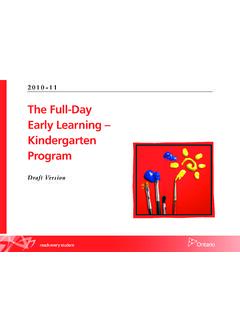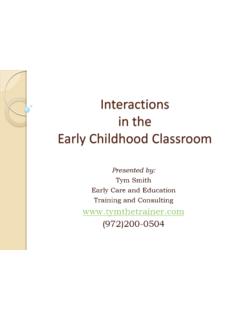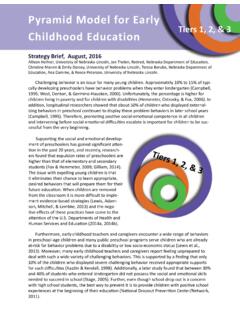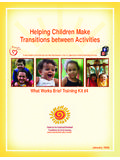Interactions Expectations For Early
Found 7 free book(s)The Full-Day Early Learning – Kindergarten Program
edu.gov.on.caThese early interactions directly affect the way connections are made in the brain. Early learning experiences are crucial to the future well-being of children, ... Expectations should be challenging but attainable, and the learning environment needs to reflect the social and cultural context in
21st CENTURY LEARNING FOR EARLY CHILDHOOD GUIDE
static.battelleforkids.orgNeuroscientists, educators, and early childhood development experts agree that early experiences have a major impact on the development of the brain and learning as adults. The brain has the greatest plasticity, or is the most flexible, during infancy through age five to accommodate a wide range of experiences, interactions, and environments.
Early Childhood Expulsion and Suspension Policy
www.tn.govEarly childhood education programs are responsible for ... age appropriate expectations, small group activities, teachable moments and knowledge of research based evidence and best practices in child ... - Adapt learning environments to promote healthy social interactions with …
Interactions in the Early Childhood Classroom
www.tymthetrainer.comExpectations of children’s social behavior are developmentally appropriate. Teachers support children’s beginning of friendships and provide opportunities for children to learn from each other as well as adults. Infants interact (look, touch gently, vocalize) freely with one another as teachers observe, alert to respond and
Pyramid Model for Early Tiers 1, 2, & 3 Childhood Education
k12engagement.unl.eduhigh-quality early childhood education which include: 1) Holistic, 2) Nurturing, 3) Con-sistent, 4) Hands-on, 5) Stimu-lating, 6) Exploratory, and 7) Interactive learning across the curriculum. These environ-ments promote appropriate behavior through the explicit teaching of rules and expec-tations. When children are taught rules and expectations,
Early Childhood Behavior Management - Vanderbilt University
iris.peabody.vanderbilt.edubackgrounds . Ms . Allegra’s new school has three school-wide behavior expectations: be respectful, be responsible, be safe . She needs to develop classroom rules that align with these behavior expectations, keeping in mind the age of the students and the diversity of her classroom . Ms . Allegra welcomes the opportunity to work on her classroom
Helping Children Make Transitions between Activities
csefel.vanderbilt.edua bell). Teach children expectations such as which shelves hold which blocks. • Minimize the number of transitions during which all children have to do the same thing at the same time (e.g., Do all children have to go to the restroom at the same time? Can some children come over to the rug and get ready for






